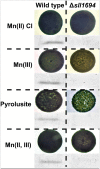Manganese acquisition is facilitated by PilA in the cyanobacterium Synechocystis sp. PCC 6803
- PMID: 29016622
- PMCID: PMC5634550
- DOI: 10.1371/journal.pone.0184685
Manganese acquisition is facilitated by PilA in the cyanobacterium Synechocystis sp. PCC 6803
Abstract
Manganese is an essential element required by cyanobacteria, as it is an essential part of the oxygen-evolving center of photosystem II. In the presence of atmospheric oxygen, manganese is present as manganese oxides, which have low solubility and consequently provide low bioavailability. It is unknown if cyanobacteria are able to utilize these manganese sources, and what mechanisms may be employed to do so. Recent evidence suggests that type IV pili in non-photosynthetic bacteria facilitate electron donation to extracellular electron acceptors, thereby enabling metal acquisition. Our present study investigates whether PilA1 (major pilin protein of type IV pili) enables the cyanobacterium Synechocystis PCC 6808 to access to Mn from manganese oxides. We present physiological and spectroscopic data, which indicate that the presence of PilA1 enhances the ability of cyanobacteria to grow on manganese oxides. These observations suggest a role of PilA1-containing pili in cyanobacterial manganese acquisition.
Conflict of interest statement
Figures






References
-
- Blankenship RE. Early evolution of photosynthesis. Plant physiology. 2010;154(2):434–8 doi: 10.1104/pp.110.161687 - DOI - PMC - PubMed
-
- Coale KH, Johnson KS, Fitzwater SE, Gordon RM, Tanner S, Chavez FP, et al. A massive phytoplankton bloom induced by an ecosystem-scale iron fertilization experiment in the equatorial Pacific Ocean. Nature. 1996;383(6600):495–501. - PubMed
-
- Martin JH, Coale KH, Johnson KS, Fitzwater SE, Gordon RM, Tanner SJ, et al. Testing the iron hypothesis in ecosystems of the equatorial Pacific Ocean. Nature. 1994;371(6493):123–9.
-
- Keren N, Kidd MJ, Penner-Hahn JE, Pakrasi HB. A light-dependent mechanism for massive accumulation of manganese in the photosynthetic bacterium Synechocystis sp. PCC 6803. Biochemistry. 2002;41(50):15085–92. - PubMed
MeSH terms
Substances
LinkOut - more resources
Full Text Sources
Other Literature Sources
Molecular Biology Databases

